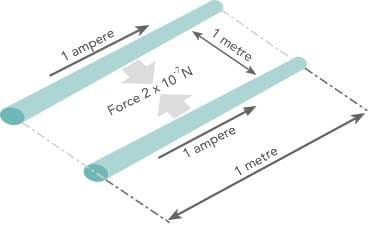Unit of Electric Current: ampere, amp
The ampere or amp is the SI unit of electric current, enabling the volume of current in a circuit to be defined.
Electric Current Tutorial Includes:
What is electric current
Current unit - Ampere
AC & DC
It is important to be able to quantify the amount of current flowing in a circuit as it enables the performance of the circuit to be defined and for the circuit to operate as required.
To achieve this it is necessary to have a unit and this is the ampere or amp. The abbreviation for this is ‘A’. A current of ten amperes may be written as 10 amps or 10A.
Note: the name of the physicist Ampère is spelt with capital A and with the accent, the term of the unit of current is ampere or amp without the capital letter or accent.
Unit of current; ampere definition
The ampere is equivalent to a charge of one coulomb per second flowing in a circuit. Although this is the practical realisation of the ampere, the formal definition relates the level of current to basic SI parameters.
Ampere definition:
The formal definition of an ampere is the constant current which if maintained in two straight parallel conductors of infinite length, of negligible circular cross section, and placed one meter apart in vacuum, would produce between these conductors a force equal to 2 × 10−7newton per metre of length.

The ampere is the SI unit of electric current and it is one of the seven SI base units
Interestingly one ampere is approximately equivalent to approximately 6.24×1018 elementary charges such as electrons or holes moving past a given point or boundary in one second.
Physicists consider current to flow from relatively positive points to relatively negative points; this is called conventional current or Franklin current.
This definition utilises electromagnetism to define the unit of current. This leads on to implicitly determine the value for the magnetic constant µ0 = 4 π 10-7 Hm-1 = 4 π 10-7 m kg s2 A-2. Therefore, the base unit ampere - and thus all other electrical units - is related to the base units meter, kilogram and second via this fundamental constant.
History of the ampere
The unit of current; the ampere is named after André-Marie Ampère who one of the early pioneers in electrical science.
Note on André-Marie Ampère:
André-Marie Ampère (1775–1836) was a French mathematician and physicist. He undertook many experiments associated with the early science of electricity and in view of his pioneering work he is considered by many to be the father of electrodynamics.
Read more about André-Marie Ampère.
In view of the really fundamental work that was undertaken by Ampère, the unit of measurement for electric current, the ampere was named after him. This was in recognition of his great contribution to setting in place many of the fundamentals of modern electrical science. The name ampere was established as a standard unit of electrical measurement at an international convention signed in 1881.
Multiples and sub-multiples for amperes
The range of current carried in different scenarios varies enormously – by many orders of magnitude. It is therefore necessary to use the standard multiples and sub-multiples.
| Multiples & Submultiples of amperes | ||
|---|---|---|
| Current | Name | Abbreviation |
| 10-15 amperes | femtoamps | fA |
| 10-12 amperes | picoamps | pA |
| 10-9 amperes | nanoamps | nA |
| 10-6 amperes | microamps | µA |
| 10-3 amperes | milliamps | mA |
| amperes | amps | A |
| 103 amperes | kiloamps | kA |
| 106 amperes | Mega amps | MA |
Current in amperes of typical devices
Different devices use different levels of current and on often wonders how many amps a device might use. The table below gives a list of the typical current in amps used by a number of different electrical and electronic items.
| Typical current in amperes of common devices | ||
|---|---|---|
| Device | Details | Typical current |
| Electric fire | 1kW bar running from 240V mains supply | 4 amps |
| Desktop computer | Computer being used and not in standby | ~ 0.5 amps |
| Kettle | Typical 2.5 kW kettle running on 240 volts | 10 amps |
| Laptop computer | On being charged | ~0.2 amps |
| Television | Example of typical 42 inch LED flat screen TV | ~0.3 amps |
The ampere is one of the seven base SI units and as such it is key to electrical and electronic science as well as many other areas of science. The definition is based upon the electromagnetic effect it induces giving it a fundamental definition.
More Basic Electronics Concepts & Tutorials:
Voltage
Current
Power
Resistance
Capacitance
Inductance
Transformers
Decibel, dB
Kirchoff's Laws
Q, quality factor
RF noise
Waveforms
Return to Basic Electronics Concepts menu . . .



